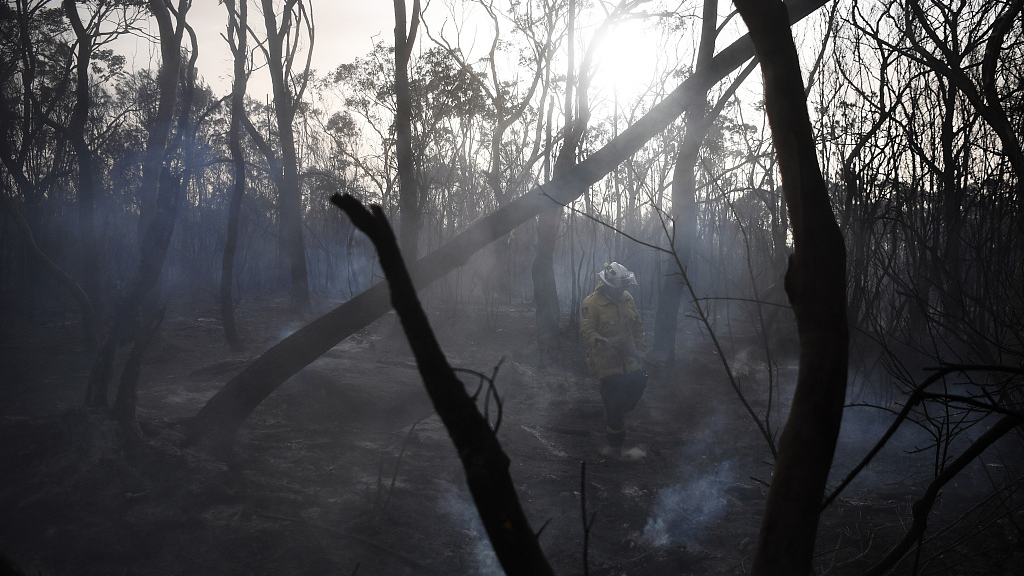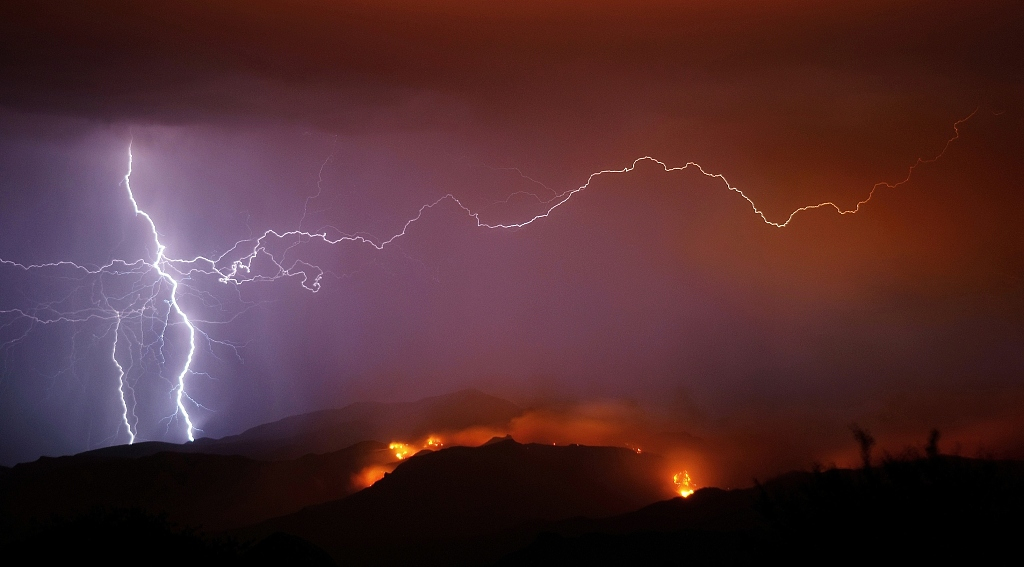
Firefighters tackle a bushfire to save a home in Taree, 350km north of Sydney on November 9 as they try to contain dozens of out-of-control blazes that are raging in the state of New South Wales. /VCG Photo
Firefighters tackle a bushfire to save a home in Taree, 350km north of Sydney on November 9 as they try to contain dozens of out-of-control blazes that are raging in the state of New South Wales. /VCG Photo
Wildfires, such as those raging across eastern Australia, have become more common across the world in recent years. AFP talked to scientists about the ways in which climate change can make them worse.
Other factors have also fueled an increase in the frequency and intensity of major fires, including human encroachment on wooded areas, and questionable forest management.

A fire rages in Bobin, 350 kilometers north of Sydney, on November 9. Firefighters have been trying to contain dozens of out-of-control blazes that are raging in the state of New South Wales. /VCG Photo
A fire rages in Bobin, 350 kilometers north of Sydney, on November 9. Firefighters have been trying to contain dozens of out-of-control blazes that are raging in the state of New South Wales. /VCG Photo

Catastrophic bushfires in eastern Australia have killed at least three people and forced thousands from their homes, with the death toll expected to rise as firefighters struggle towards hard-to-reach communities. /VCG Photo
Catastrophic bushfires in eastern Australia have killed at least three people and forced thousands from their homes, with the death toll expected to rise as firefighters struggle towards hard-to-reach communities. /VCG Photo

Firefighters tackle a bushfire to save a home in Taree, 350 kilometers north of Sydney on November 9. /VCG Photo
Firefighters tackle a bushfire to save a home in Taree, 350 kilometers north of Sydney on November 9. /VCG Photo

Firefighters tackle a bushfire to save a home in Taree, 350 kilometers north of Sydney on November 9. /VCG Photo
Firefighters tackle a bushfire to save a home in Taree, 350 kilometers north of Sydney on November 9. /VCG Photo

Firefighters tackle a bushfire to save a home in Taree, 350 kilometers north of Sydney on November 9. /VCG Photo
Firefighters tackle a bushfire to save a home in Taree, 350 kilometers north of Sydney on November 9. /VCG Photo

NSW Rural Fire Service firefighters mop up after a bushfire in the suburb of Llandilo on November 12 in Sydney, Australia. /VCG Photo
NSW Rural Fire Service firefighters mop up after a bushfire in the suburb of Llandilo on November 12 in Sydney, Australia. /VCG Photo

More than 50 fires are burning across NSW with 200 homes and sheds destroyed and three people confirmed dead. /VCG Photo
More than 50 fires are burning across NSW with 200 homes and sheds destroyed and three people confirmed dead. /VCG Photo

Catastrophic fire danger - the highest possible level of bushfire danger - has been forecast for the greater Sydney, Illawarra and Hunter areas which includes the Blue Mountains and the Central Coast. /VCG Photo
Catastrophic fire danger - the highest possible level of bushfire danger - has been forecast for the greater Sydney, Illawarra and Hunter areas which includes the Blue Mountains and the Central Coast. /VCG Photo

NSW Rural Fire Service firefighters mop up after a bushfire in the suburb of Llandilo on November 12 in Sydney, Australia. /VCG Photo
NSW Rural Fire Service firefighters mop up after a bushfire in the suburb of Llandilo on November 12 in Sydney, Australia. /VCG Photo

NSW Rural Fire Service firefighters mop up after a bushfire in the suburb of Llandilo on November 12 in Sydney, Australia. /VCG Photo
NSW Rural Fire Service firefighters mop up after a bushfire in the suburb of Llandilo on November 12 in Sydney, Australia. /VCG Photo

More than 50 fires are burning across NSW with 200 homes and sheds destroyed and three people confirmed dead. /VCG Photo
More than 50 fires are burning across NSW with 200 homes and sheds destroyed and three people confirmed dead. /VCG Photo
"The patient was already sick," said David Bowman, a professor of environmental change biology at the University of Tasmania and a wildfire expert. "But climate change is the accelerant."

A firefighter works as a bushfire, believed to have been sparked by a lightning strike that has ravaged an area of over 2,000 hectares in northern New South Wales state, burns in Port Macquarie on November 2, 2019. /VCG Photo
A firefighter works as a bushfire, believed to have been sparked by a lightning strike that has ravaged an area of over 2,000 hectares in northern New South Wales state, burns in Port Macquarie on November 2, 2019. /VCG Photo
Any firefighter can tell you the recipe for a conducive fire weather: hot, dry and windy.
No surprise, then, that many of the tropical and temperate regions devastated by a surge in forest fires are those predicted in climate models to see higher temperatures and more droughts.
"Besides bringing more dry and hot air, climate change - by elevating evaporation rates and drought prevalence - also creates more flammable ecosystems," noted Christopher Williams, director of environmental sciences at Clark University in Massachusetts.

A firefighter works as a bushfire, believed to have been sparked by a lightning strike that has ravaged an area of over 2,000 hectares in northern New South Wales state, burns in Port Macquarie on November 2, 2019. /VCG Photo
A firefighter works as a bushfire, believed to have been sparked by a lightning strike that has ravaged an area of over 2,000 hectares in northern New South Wales state, burns in Port Macquarie on November 2, 2019. /VCG Photo
Dry weather means more dead trees, shrubs and grass, which means more fuel for the fire.
"All those extremely dry years create an enormous amount of desiccated biomass," said Michel Vennetier, an engineer at France's National Research of Science and Technology for Environment and Agriculture (IRSTEA).
"That's an ideal combustible."

NSW Premier Gladys Berejiklian declared a state of emergency on Monday, giving emergency powers to Rural Fire Service Commissioner Shane Fitzsimmons and prohibiting fires across the state while almost 600 schools have also been closed as a safety precaution. /VCG Photo
NSW Premier Gladys Berejiklian declared a state of emergency on Monday, giving emergency powers to Rural Fire Service Commissioner Shane Fitzsimmons and prohibiting fires across the state while almost 600 schools have also been closed as a safety precaution. /VCG Photo
To make matters worse, new species better adapted to semi-arid conditions grow in their place.
"Plants that like humidity have disappeared, replaced by more flammable plants that can withstand dry conditions, like rosemary, wild lavender and thyme," said Vennetier.
"The change happens quite quickly."

Hundreds of koalas are feared to have burned to death in an out-of-control bushfire on Australia's east coast. /VCG Photo
Hundreds of koalas are feared to have burned to death in an out-of-control bushfire on Australia's east coast. /VCG Photo
With rising mercury and less rain, water-stressed trees and shrubs send roots deeper into the soil, sucking up every drop of water they can to nourish leaves and needles.
That means the moisture in the earth that might have helped to slow a fire sweeping through a forest or garrigue is no longer there.

Dry plants are more prone to catching fire. /VCG Photo
Dry plants are more prone to catching fire. /VCG Photo
"The warmer it gets, the more lightning you have," said Mike Flannigan, a professor at the University of Alberta, Canada and director of the Western Partnership for Wildland Fire Science.
At the same time, he noted that 95 percent of wildfires worldwide are started by humans.

Lightnings can ignite wild fire as well. /VCG Photo
Lightnings can ignite wild fire as well. /VCG Photo
Normal weather patterns over North America and Eurasia depend heavily on the powerful, high-altitude air currents - produced by the contrast between polar and equatorial temperatures - known as the jet stream.
But global warming has raised temperatures in the Arctic twice as fast as the global average, weakening those currents.
"We are seeing more extreme weather because of what we call blocked ridges, which is a high-pressure system in which air is sinking, getting warmer and drier along the way," said Flannigan.
"Firefighters have known for decades that these are conducive to fire activity."

A NSW RFS firefighter mops up at South Turramurra on November 12, 2019 in Sydney, Australia. /VCG Photo
A NSW RFS firefighter mops up at South Turramurra on November 12, 2019 in Sydney, Australia. /VCG Photo
In the southern hemisphere, the periodic, every two to seven years, weather cycle known as El Nino leads to reduced rainfall, warmer temperatures and increased fire risk in Indonesia and eastern Australia, especially the southeast. The current fires, however, are not influenced by an El Nino event.

View of a dock at the dried lake of the Peace Park in San Jose on May 14, 2019. The lake was affected by droughts produced by El Nino phenomenon. The Peace Park is the second largest public space in the Costa Rican capital with an estimated of over 500,000 visitors a year. /VCG Photo
View of a dock at the dried lake of the Peace Park in San Jose on May 14, 2019. The lake was affected by droughts produced by El Nino phenomenon. The Peace Park is the second largest public space in the Costa Rican capital with an estimated of over 500,000 visitors a year. /VCG Photo
Climate change not only boosts the likelihood of wildfires, but their intensity as well.
"If the fire gets too intense" as in Australia right now, and in Greece last summer, "there is no direct measure you can take to stop it," said Flannigan.
"It's like spitting on a campfire."

A NSW Rural Fire Service firefighter mops up after a bushfire in the suburb of Llandilo, Sydney, Australia, November 12, 2019. /VCG Photo
A NSW Rural Fire Service firefighter mops up after a bushfire in the suburb of Llandilo, Sydney, Australia, November 12, 2019. /VCG Photo
With rising temperatures, beetles have moved northward into Canada's boreal forests, wreaking havoc and killing trees along the way.
"Bark beetle outbreaks temporarily increase forest flammability by increasing the amount of dead material, such as needles," said Williams.

Bark beetle outbreaks may cause serious damage to the forest. /VCG Photo
Bark beetle outbreaks may cause serious damage to the forest. /VCG Photo
Globally, forests hold about 45 percent of Earth's land-locked carbon and soak up a quarter of human greenhouse gas emissions.
But as forests die and burn, some of the carbon is released back into the atmosphere, contributing to climate change in a vicious circle that scientists call "positive feedback."
(Cover photo via VCG)
(If you want to contribute and have specific expertise, please contact us at nature@cgtn.com.)
Source(s): AFP